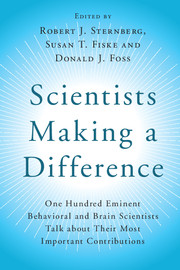 Scientists Making a Difference
Scientists Making a Difference Book contents
- Frontmatter
- Contents
- List of Contributors
- Foreword: Making a Creative Difference = Person × Environment
- Preface
- Part I Introduction
- Part II Biological Bases of Psychology: Genes, Brain, and Beyond
- Part III Cognition: Getting Information from the World and Dealing with It
- Section A Attention and Perception
- Section B Learning and Memory
- Section C Complex Processes
- 34 A Unified Theory of Mind
- 35 Multiple Intelligences: Prelude, Theory, and Aftermath
- 36 Heuristics and Biases
- 37 Comprehension
- 38 The Perception of Risk
- 39 What Does It Mean to Be Intelligent?
- Part IV Development: How We Change Over Time
- Part V Motivation and Emotion: How We Feel and What We Do
- Part VI Social and Personality Processes: Who We Are and How We Interact
- Part VII Clinical and Health Psychology: Making Lives Better
- Part VIII Conclusion
- Afterword: Doing Psychology 24×7 and Why It Matters
- Index
- References
36 - Heuristics and Biases
from Section C - Complex Processes
Published online by Cambridge University Press: 05 August 2016
- Frontmatter
- Contents
- List of Contributors
- Foreword: Making a Creative Difference = Person × Environment
- Preface
- Part I Introduction
- Part II Biological Bases of Psychology: Genes, Brain, and Beyond
- Part III Cognition: Getting Information from the World and Dealing with It
- Section A Attention and Perception
- Section B Learning and Memory
- Section C Complex Processes
- 34 A Unified Theory of Mind
- 35 Multiple Intelligences: Prelude, Theory, and Aftermath
- 36 Heuristics and Biases
- 37 Comprehension
- 38 The Perception of Risk
- 39 What Does It Mean to Be Intelligent?
- Part IV Development: How We Change Over Time
- Part V Motivation and Emotion: How We Feel and What We Do
- Part VI Social and Personality Processes: Who We Are and How We Interact
- Part VII Clinical and Health Psychology: Making Lives Better
- Part VIII Conclusion
- Afterword: Doing Psychology 24×7 and Why It Matters
- Index
- References
Summary
My life changed when I invited my brilliant colleague Amos Tversky to give a guest lecture. Amos told my graduate seminar at the Hebrew University of Jerusalem about recent research at the University of Michigan, which had concluded that people are good intuitive statisticians. I thought that claim was completely wrong (Israelis tend not to mince words), and we had an intense and enjoyable conversation. Over the next few days we sketched an idea – perhaps the most productive either of us ever had – and decided to collaborate in the study of intuitive statistical thinking.
Our goal was to understand how people answer questions such as “what GPA will this student achieve?” or “what proportion of professors at our university have been divorced at least once?” We knew that people come up quickly with intuitive answers to such questions, without consulting statistical principles. How do they do it, and why are these intuitions so often wrong? In 1969 these were new questions. We reported our main conclusions five years later: “people rely on a limited number of heuristic principles which reduce the complex tasks of assessing probabilities and predicting values to simpler judgmental operations. In general, these heuristics are quite useful, but sometimes they lead to severe and systematic errors” (Tversky and Kahneman, 1974). We borrowed the term “heuristic” from the literature on problem solving, where it refers to computational short-cuts that are quick and efficient, but not guaranteed to produce the correct answer.
For an example of how intuitive statistical thinking can be analyzed, consider this question:
Julie is a graduating senior at a University. All I will tell you about her is that she read fluently at age 4. What is her GPA?
I expect that a number quickly came to your mind, probably not very far from 3.7. You were probably not aware of how the number came up, but there it was. The research program that Amos and I started has established that you – your mind, your memory – carried out several operations to produce your intuitive estimate.
(1) The evidence “read fluently at age 4” was assessed for precocity, yielding something like a percentile. This percentile was high – say, 95.
(2) The GPA that corresponds to the 95th percentile was identified.
- Type
- Chapter
- Information
- Scientists Making a DifferenceOne Hundred Eminent Behavioral and Brain Scientists Talk about Their Most Important Contributions, pp. 171 - 174Publisher: Cambridge University PressPrint publication year: 2016
References
- 1
- Cited by
